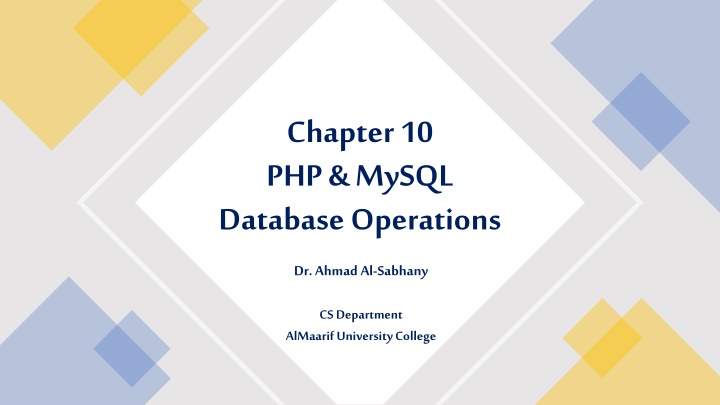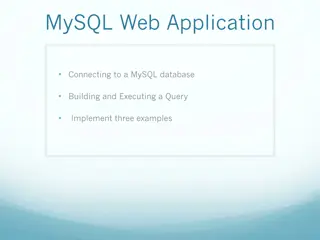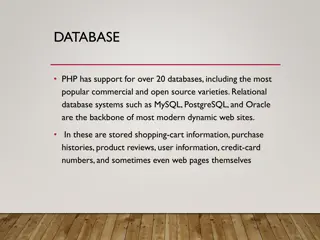PHP & MySQL Database Operations
PHP allows you to connect to and manipulate databases, with MySQL being the most popular database system used. Learn about MySQL, how to open a connection to it, create databases, and perform various operations.
Download Presentation

Please find below an Image/Link to download the presentation.
The content on the website is provided AS IS for your information and personal use only. It may not be sold, licensed, or shared on other websites without obtaining consent from the author.If you encounter any issues during the download, it is possible that the publisher has removed the file from their server.
You are allowed to download the files provided on this website for personal or commercial use, subject to the condition that they are used lawfully. All files are the property of their respective owners.
The content on the website is provided AS IS for your information and personal use only. It may not be sold, licensed, or shared on other websites without obtaining consent from the author.
E N D
Presentation Transcript
Chapter 10 PHP & MySQL Database Operations Dr. Ahmad Al-Sabhany CS Department AlMaarifUniversity College
Outline MySQL introduction MySQL Connect Statement MySQL Create Database MySQL Create a Table MySQL Insert Data Commit Queries Prepared Statements MySQL Select Data MySQL Select Data WHERE & ORDER BY MySQL Delete Data MySQL Update Data MySQL Limit Dr. Ahmad AlSabhany CS Dept | AlMaarif University College 1/9/2022 2
What is MySQL? With PHP, you can connect to and manipulate databases. MySQL is the most popular database system used with PHP. About MySQL MySQL is a database system used on the web MySQL is a database system that runs on a server MySQL is ideal for both small and large applications MySQL is very fast, reliable, and easy to use MySQL uses standard SQL MySQL is free to download and use The data in a MySQL database are stored in tables. A table is a collection of related data, and it consists of columns and rows. Dr. Ahmad AlSabhany CS Dept | AlMaarif University College 1/9/2022 3
Open a Connection to MySQL <?php $servername = "localhost"; $username = "username"; $password = "password"; // Create connection $conn = new mysqli($servername, $username, $password); // Check connection if ($conn->connect_error) { die("Connection failed: " . $conn->connect_error); } echo "Connected successfully"; ?> Open a Connection to MySQL Before we can access data in the MySQL database, we need to be able to connect to the server: Dr. Ahmad AlSabhany CS Dept | AlMaarif University College 1/9/2022 4
Close the Connection if ($conn->ping()) { printf ("Our connection is ok!\n"); } else { printf ("Error: %s\n", $conn->error); } $conn->close(); if ($conn->ping()) { printf ("Our connection is ok!\n"); } else { printf ("Error: %s\n", $conn->error); } The connection will be closed automatically when the script ends. To close the connection before, use the following: $conn->close(); Dr. Ahmad AlSabhany CS Dept | AlMaarif University College 1/9/2022 5
Create a MySQL Database The CREATE DATABASE statement is used to create a database in MySQL. When you create a new database, you must only specify the first three arguments to the mysqli object (servername, username and password). // Create database $sql = "CREATE DATABASE myDB"; if ($conn->query($sql) === TRUE) { echo "Database created successfully"; } else { echo "Error creating database: " . $conn- >error; } Dr. Ahmad AlSabhany CS Dept | AlMaarif University College 1/9/2022 6
MySQL Create a Table // sql to create table $sql = "CREATE TABLE MyGuests ( id INT(6) UNSIGNED AUTO_INCREMENT PRIMARY KEY, firstname VARCHAR(30) NOT NULL, lastname VARCHAR(30) NOT NULL, email VARCHAR(50), reg_date TIMESTAMP DEFAULT CURRENT_TIMESTAMP ON UPDATE CURRENT_TIMESTAMP )"; if ($conn->query($sql) === TRUE) { echo "Table MyGuests created successfully"; } else { echo "Error creating table: " . $conn->error; } The CREATE TABLE statement is used to create a table in MySQL. Note that the connection statement must include the database name Dr. Ahmad AlSabhany CS Dept | AlMaarif University College 1/9/2022 7
MySQL Insert Data After a database and a table have been created, we can start adding data in them. Here are some syntax rules to follow: The SQL query must be quoted in PHP String values inside the SQL query must be quoted Numeric values must not be quoted The word NULL must not be quoted The INSERT INTO statement is used to add new records to a MySQL table: Syntax: INSERT INTO table_name (column1, column2, column3,...) VALUES (value1, value2, value3,...) Dr. Ahmad AlSabhany CS Dept | AlMaarif University College 1/9/2022 8
Insert Example $sql = "INSERT INTO MyGuests (firstname, lastname, email) VALUES ('John', 'Doe', 'john@example.com')"; The INSERT INTO statement is used to create a table in MySQL. Note that the connection statement must include the database name $conn->insert_id hold the id of the latest insert if ($conn->query($sql) === TRUE) { $last_id = $conn->insert_id; echo "New record created successfully. Last inserted ID is: " . $last_id; } else { echo "Error: " . $sql . "<br>" . $conn->error; } Dr. Ahmad AlSabhany CS Dept | AlMaarif University College 1/9/2022 9
Commit Queries $sql = "INSERT INTO MyGuests (firstname, lastname, email) VALUES ('John', 'Doe', 'john@example.com')"; Note that each SQL Statement must be executed either in the if statement or in a variable assignment $commit = $conn->query($sql); echo "New record created successfully."; Dr. Ahmad AlSabhany CS Dept | AlMaarif University College 1/9/2022 10
Insert Multiple Records $sql = "INSERT INTO MyGuests (firstname, lastname, email) VALUES ('John', 'Doe', 'john@example.com');"; $sql .= "INSERT INTO MyGuests (firstname, lastname, email) VALUES ('Mary', 'Moe', 'mary@example.com');"; $sql .= "INSERT INTO MyGuests (firstname, lastname, email) VALUES ('Julie', 'Dooley', 'julie@example.com')"; if ($conn->multi_query($sql) === TRUE) { echo "New records created successfully"; } else { echo "Error: " . $sql . "<br>" . $conn->error; } Multiple SQL statements must be executed with the mysqli_multi_query() function. Dr. Ahmad AlSabhany CS Dept | AlMaarif University College 1/9/2022 11
Prepared Statements and Bound Parameters A prepared statement is a feature used to execute the same (or similar) SQL statements repeatedly with high efficiency. Prepared statements are very useful against SQL injections. Prepared statements basically work like this: 1. Prepare: An SQL statement template is created and sent to the database. Certain values are left unspecified, called parameters (labeled "?"). Example: INSERT INTO MyGuests VALUES(?, ?, ?) 2. The database parses, compiles, and performs query optimization on the SQL statement template, and stores the result without executing it 3. Execute: At a later time, the application binds the values to the parameters, and the database executes the statement. The application may execute the statement as many times as it wants with different values Dr. Ahmad AlSabhany CS Dept | AlMaarif University College 1/9/2022 12
Prepared Statements and Bound Parameters (2) Compared to executing SQL statements directly, prepared statements have three main advantages: A. Prepared statements reduce parsing time as the preparation on the query is done only once (although the statement is executed multiple times) B. Bound parameters minimize bandwidth to the server as you need send only the parameters each time, and not the whole query C. Prepared statements are very useful against SQL injections, because parameter values, which are transmitted later using a different protocol, need not be correctly escaped. If the original statement template is not derived from external input, SQL injection cannot occur. Dr. Ahmad AlSabhany CS Dept | AlMaarif University College 1/9/2022 13
Prepared Statements and Bound Parameters (Example) // set parameters and execute $firstname = "John"; $lastname = "Doe"; $email = "john@example.com"; $stmt->execute(); $firstname = "Mary"; $lastname = "Moe"; $email = "mary@example.com"; $stmt->execute(); <?php $servername = "localhost"; $username = "username"; $password = "password"; $dbname = "myDB"; // Create connection $conn = new mysqli($servername, $username, $password, $dbname); // Check connection if ($conn->connect_error) { die("Connection failed: " . $conn->connect_error); } echo "New records created successfully"; $stmt->close(); $conn->close(); ?> // prepare and bind $stmt = $conn->prepare("INSERT INTO MyGuests (firstname, lastname, email) VALUES (?, ?, ?)"); $stmt->bind_param("sss", $firstname, $lastname, $email); Dr. Ahmad AlSabhany CS Dept | AlMaarif University College 1/9/2022 14
Prepared Statements and Bound Parameters (Example) "INSERT INTO MyGuests (firstname, lastname, email) VALUES (?, ?, ?) In our SQL, we insert a question mark (?) where we want to substitute in an integer, string, double or blob value. $stmt->bind_param("sss", $firstname, $lastname, $email); This function binds the parameters to the SQL query and tells the database what the parameters are. The "sss" argument lists the types of data that the parameters are. The s character tells mysql that the parameter is a string. The argument may be one of four types: i - integer d - double s - string b - BLOB We must have one of these for each parameter. By telling mysql what type of data to expect, we minimize the risk of SQL injections Note: If we want to insert any data from external sources (like user input), it is very important that the data is sanitized and validated. Dr. Ahmad AlSabhany CS Dept | AlMaarif University College 1/9/2022 15
Prepared Statements and Bound Parameters (Example) <?php $servername = "localhost"; $username = "username"; $password = "password"; $dbname = "myDB"; // Create connection $conn = new mysqli($servername, $username, $password, $dbname); // Check connection if ($conn->connect_error) { die("Connection failed: " . $conn- >connect_error); } $sql = "SELECT id, firstname, lastname FROM MyGuests WHERE lastname='Doe'"; $result = $conn->query($sql); if ($result->num_rows > 0) { // output data of each row while($row = $result->fetch_assoc()) { echo "id: " . $row["id"]. " - Name: " . $row["firstname"]. " " . $row["lastname"]. "<br>"; } } else { echo "0 results"; } $conn->close(); Dr. Ahmad AlSabhany CS Dept | AlMaarif University College 1/9/2022 16
PHP MySQL Select Data The SELECT statement is used to select data from one or more tables: SELECT column_name(s) FROM table_name or we can use the * character to select ALL columns from a table: SELECT * FROM table_name $sql = "SELECT id, firstname, lastname FROM MyGuests"; $result = $conn->query($sql); while($row = $result->fetch_assoc()) { echo "id: " . $row["id"]. " - Name: " . $row["firstname"]. " " . $row["lastname"]. "<br>"; } Dr. Ahmad AlSabhany CS Dept | AlMaarif University College 1/9/2022 17
PHP MySQL Select Data (Example 1) The SELECT statement is used to select data from one or more tables: SELECT column_name(s) FROM table_name or we can use the * character to select ALL columns from a table: SELECT * FROM table_name $sql = mysqli_query($conn,"SELECT id, firstname, lastname FROM MyGuests"); while ($assoc = mysqli_fetch_array($sql)){ echo $assoc[0]. " " . $assoc[1]. " ". $assoc[2]."<br>"; } Dr. Ahmad AlSabhany CS Dept | AlMaarif University College 1/9/2022 18
MySQL WHERE clause Select and Filter Data From a MySQL Database The WHERE clause is used to filter records. The WHERE clause is used to extract only those records that fulfill a specified condition. SELECT column_name(s) FROM table_name WHERE column_name operator value First, we set up the SQL query that selects the id, firstname and lastname columns from the MyGuests table where the lastname is "Doe". The next line of code runs the query and puts the resulting data into a variable called $result. Then, the function num_rows() checks if there are more than zero rows returned. If there are more than zero rows returned, the function fetch_assoc() puts all the results into an associative array that we can loop through. The while() loop loops through the result set and outputs the data from the id, firstname and lastname columns. Dr. Ahmad AlSabhany CS Dept | AlMaarif University College 1/9/2022 19
MySQL ORDER BY Clause $sql = "SELECT id, firstname, lastname FROM MyGuests ORDER BY lastname"; $result = $conn->query($sql); Select and Order Data From a MySQL Database The ORDER BY clause is used to sort the result-set in ascending or descending order. The ORDER BY clause sorts the records in ascending order by default. To sort the records in descending order, use the DESC keyword. SELECT column_name(s) FROM table_name ORDER BY column_name(s) ASC|DESC while($row = $result->fetch_assoc()) { echo "id: " . $row["id"]. " - Name: " . $row["firstname"]. " " . $row["lastname"]. "<br>"; Dr. Ahmad AlSabhany CS Dept | AlMaarif University College 1/9/2022 20
MySQL Delete Data $sql = "DELETE FROM MyGuests WHERE firstname= Ahmad'"; if ($conn->query($sql) === TRUE) { echo "Record deleted successfully"; } else { echo "Error deleting record: " . $conn->error; } ////////or $sql = "DELETE FROM MyGuests WHERE firstname= Ahmad'"; $del = $conn->query($sql); The DELETE statement is used to delete records from a table: DELETE FROM table_name WHERE some_column = some_value Dr. Ahmad AlSabhany CS Dept | AlMaarif University College 1/9/2022 21
MySQL Update Data The UPDATE statement is used to update existing records in a table: UPDATE table_name SET column1=value, column2=value2,... WHERE some_column=some_value Notice the WHERE clause in the UPDATE syntax: The WHERE clause specifies which record or records that should be updated. If you omit the WHERE clause, all records will be updated! $sql ="UPDATE MyGuests SET lastname='Ahmad' WHERE id=2"; if($conn->query($sql) === TRUE) { echo"Record updated successfully"; }else{ echo"Error updating record: ". $conn->error; } ////or $sql ="UPDATE MyGuests SET firstname='Ahmad' WHERE id=2"; $del = $conn->query($sql); Dr. Ahmad AlSabhany CS Dept | AlMaarif University College 1/9/2022 22
MySQL Limit Data Selections Limit Data Selections From a MySQL Database MySQL provides a LIMIT clause that is used to specify the number of records to return. The LIMIT clause makes it easy to code multi page results or pagination with SQL, and is very useful on large tables. Returning a large number of records can impact on performance. Assume we wish to select all records from 1 - 30 (inclusive) from a table called "Orders". The SQL query would then look like this: When the SQL query above is run, it will return the first 30 records. $sql = "SELECT * FROM Orders LIMIT 30"; The SQL query below says "return only 10 records, start on record 16 (OFFSET 15)": $sql = "SELECT * FROM Orders LIMIT 10 OFFSET 15"; $sql = "SELECT * FROM Orders LIMIT 15, 10"; Dr. Ahmad AlSabhany CS Dept | AlMaarif University College 1/9/2022 23
Try it Yourself ! alsabhany@uoa.edu.iq Reference: https://www.w3schools.com/php/php_mysql_intro.asp Dr. Ahmad AlSabhany CS Dept | AlMaarif University College 1/9/2022 24























